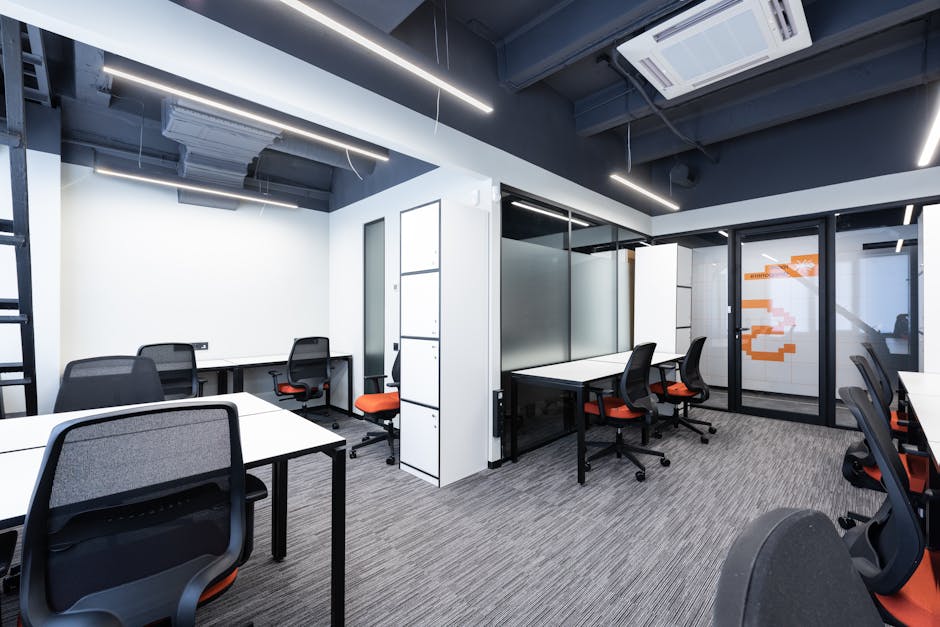Desk Sharing at Work: Boosting Efficiency and Collaboration in Modern Offices
“Explore the benefits and challenges of implementing a desk sharing policy in the workplace. This article covers strategies for increased efficiency, cost savings, and improved collaboration, along with practical tips for successful implementation and addressing common concerns. ”

The Rise of Desk Sharing in Modern Workplaces
In today's dynamic business environment, companies are constantly seeking innovative ways to optimize their operations and boost productivity. One strategy that has gained significant traction is desk sharing. This approach to workspace management is reshaping how organizations utilize their office spaces and fostering a more flexible, collaborative work environment.

Desk sharing involves employees using shared workstations rather than having designated individual desks. This concept aligns perfectly with the growing trends of remote work and hybrid schedules, offering businesses a practical solution to adapt to changing work patterns while maximizing office space utilization.
Understanding Desk Sharing Models
There are several variations of desk sharing, each with its unique characteristics:
-
Shared Desk: Two or more employees share a single desk but work different shifts, ensuring exclusive access during their work hours.
-
Hoteling: Employees reserve desks for specific periods using a booking system, similar to reserving a hotel room.
-
Hot Desking: Workers choose any available workspace upon arrival without prior reservation, promoting spontaneity and flexibility.
Each model caters to different organizational needs and work cultures. The choice depends on factors such as team dynamics, project requirements, and overall company structure.
Benefits of Implementing a Desk Sharing Policy
Increased Efficiency and Productivity
Desk sharing promotes a flexible work environment that can be tailored to individual tasks and preferences. This flexibility often leads to increased motivation and job satisfaction among employees. The dynamic nature of shared spaces also fosters increased energy and collaboration, driving operational efficiency upward.
Substantial Cost Savings
One of the most significant advantages of desk sharing is the potential for cost savings. By optimizing workspace usage, companies can reduce their real estate footprint and associated costs. This is particularly beneficial for organizations embracing hybrid work models, where not all employees are in the office simultaneously.

Enhanced Collaboration and Communication
Desk sharing breaks down departmental silos and encourages cross-functional interactions. When employees from different teams share workspaces, it creates opportunities for spontaneous collaboration and idea exchange. This increased interaction can lead to improved communication and teamwork across the organization.
Implementing a Successful Desk Sharing Policy
To reap the benefits of desk sharing, careful planning and execution are crucial. Here are some key steps to consider:
1. Assess Your Office Space
Begin by evaluating your current workspace layout. Identify areas that can be transformed into shared spaces while ensuring employee comfort and work functionality are maintained.
2. Develop a Comprehensive Policy
Create clear guidelines for desk sharing, including reservation procedures, cleanliness standards, and etiquette for shared spaces. This policy should address potential concerns and set expectations for all employees.
3. Implement a Reliable Reservation System
Invest in a user-friendly desk booking system that allows employees to easily reserve workspaces. This system should provide real-time availability and support various booking options to accommodate different work schedules.
4. Communicate Effectively
Clear communication is vital when introducing a desk sharing policy. Inform employees about the changes, explain the benefits, and provide training on new systems and procedures. Address concerns proactively and be open to feedback.
5. Provide Adequate Support and Resources
Ensure that shared workspaces are equipped with the necessary tools and technology. This may include adjustable furniture, docking stations, and sufficient storage solutions for personal items.
Overcoming Common Challenges
While desk sharing offers numerous benefits, it's not without challenges. Here are some common issues and strategies to address them:
Privacy Concerns
To address privacy issues, consider installing partitions or creating designated quiet areas for confidential work. Implement clear policies on handling sensitive information in shared spaces.
Personalization and Belongings
Provide lockers or personal storage units where employees can keep their belongings. Encourage the use of digital personalization options for shared computers to maintain a sense of individual workspace.
Cleanliness and Hygiene
Establish strict cleaning protocols for shared desks and equipment. Provide cleaning supplies and encourage employees to clean workstations before and after use. Regular professional cleaning services are also essential.

Maximizing the Benefits of Desk Sharing
To fully leverage the advantages of desk sharing, consider these additional strategies:
-
Create Diverse Work Areas: Offer a variety of workspace options, including quiet zones, collaborative areas, and casual meeting spots to cater to different work styles and tasks.
-
Leverage Technology: Utilize workplace occupancy data and analytics to optimize space usage and make informed decisions about office layout and capacity.
-
Encourage Mobility: Provide mobile technology solutions that enable employees to work efficiently from any location within the office.
-
Foster a Culture of Collaboration: Organize team-building activities and create opportunities for cross-departmental projects to maximize the collaborative potential of shared spaces.
-
Regular Feedback and Adjustment: Continuously gather employee feedback and be prepared to make adjustments to your desk sharing policy as needed.
Conclusion
Desk sharing represents a significant shift in how we approach office space and work dynamics. When implemented thoughtfully, it can lead to increased efficiency, substantial cost savings, and a more collaborative work environment. By addressing potential challenges head-on and focusing on creating a positive employee experience, organizations can successfully transition to a more flexible and dynamic workspace model.
As the nature of work continues to evolve, desk sharing offers a practical solution for businesses looking to adapt to changing workforce needs while optimizing their resources. With careful planning and execution, it can become a cornerstone of a modern, efficient, and collaborative workplace.